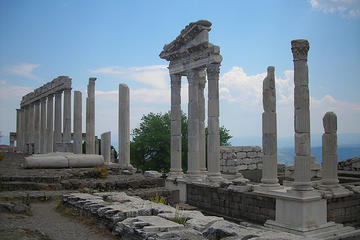
Pergamon is an ancient city dating as far back as the 5th century BC. Credited with the invention of parchment, this once great seat of learning and culture had a library with over 20,000 volumes and a medical center - the remains of which can still be seen today.
Listed in the Bible as one of the Seven Churches of Asia, Pergamon flourished until the 14th century when, under Ottoman rule, it was abandoned and left to decay. Today, much of the remains of this once magnificent city lie underneath the modern-day city of Bergama but, thanks to Pergamon’s hilltop position, the remains of its most important buildings are still visible.
The Acropolis of Pergamon is clearly visible from anywhere in Bergama and closer inspection will reveal two partially reconstructed temples (Temple of Trajan and the Temple of Athena), ancient aqueducts and the incredible hillside theater, which is said to contain the steepest theater seating in the world.
Asclepion (the ancient medical center) was centuries ahead of its time in its use of therapies to cure ills. Here you’ll find a theater and several sacred pools whose purportedly radioactive waters were used to cure patients. Once accessed via the Sacred Way from the Acropolis, these days you’ll find the Asclepion across town, west of the Bergama Museum and city center.
Other important sites at Pergamon include the Red Basilica and the Zeus Altar.
Bergama (ancient Pergamon) is 100km (62mi) north of Izmir. Pergamon’s sites are spread over a large area and most people choose to see the ancient city on a guided tour.